Packing and Packaging Theory: Refrigerators and Business Development
VerifiedAdded on 2022/08/14
|16
|3710
|19
Report
AI Summary
This report applies packaging theory to the context of refrigerator transportation, addressing the critical need for effective packaging to ensure product safety and efficient supply chain management. It begins with an executive summary and an introduction to packaging principles, emphasizing the importance of protecting delicate and valuable products like refrigerators from damage during transit. The report then details the characteristics of refrigerators, highlighting their delicate components and the potential risks during transportation. A critical analysis follows, discussing factors such as size, shape, surface condition, and weight, and how these influence packaging strategies. The report provides a comprehensive overview of packaging materials, including primary, secondary, and tertiary layers, and their roles in protecting refrigerators from shocks, vibrations, and environmental factors. It also covers package identification, transportation considerations, and concludes with a summary of key findings, emphasizing the need for robust and well-designed packaging to minimize damage and ensure customer satisfaction. The report stresses that the packaging should protect the refrigerator from the external environment and also ensure the internal components of the refrigerator remain intact and functional.
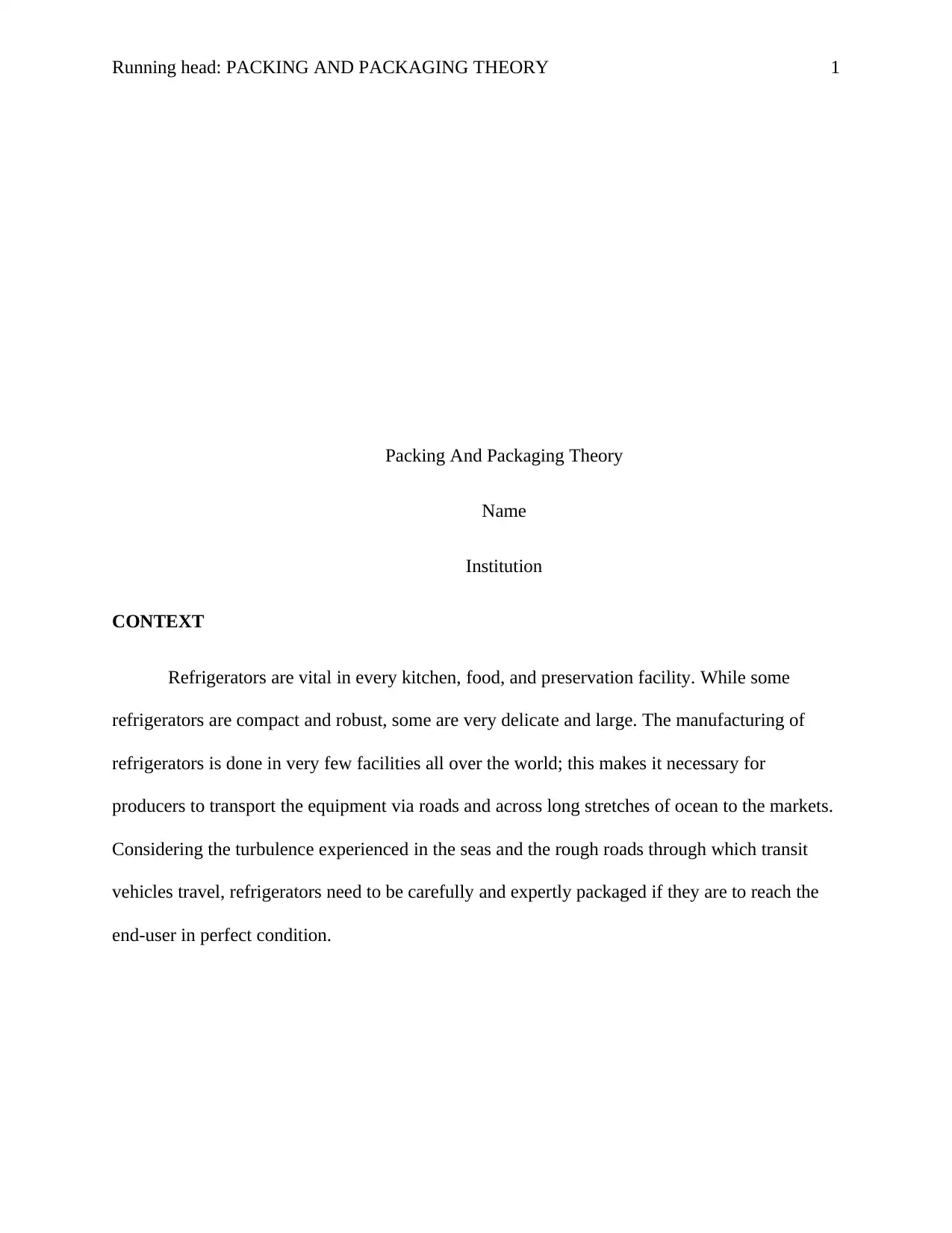
Running head: PACKING AND PACKAGING THEORY 1
Packing And Packaging Theory
Name
Institution
CONTEXT
Refrigerators are vital in every kitchen, food, and preservation facility. While some
refrigerators are compact and robust, some are very delicate and large. The manufacturing of
refrigerators is done in very few facilities all over the world; this makes it necessary for
producers to transport the equipment via roads and across long stretches of ocean to the markets.
Considering the turbulence experienced in the seas and the rough roads through which transit
vehicles travel, refrigerators need to be carefully and expertly packaged if they are to reach the
end-user in perfect condition.
Packing And Packaging Theory
Name
Institution
CONTEXT
Refrigerators are vital in every kitchen, food, and preservation facility. While some
refrigerators are compact and robust, some are very delicate and large. The manufacturing of
refrigerators is done in very few facilities all over the world; this makes it necessary for
producers to transport the equipment via roads and across long stretches of ocean to the markets.
Considering the turbulence experienced in the seas and the rough roads through which transit
vehicles travel, refrigerators need to be carefully and expertly packaged if they are to reach the
end-user in perfect condition.
Paraphrase This Document
Need a fresh take? Get an instant paraphrase of this document with our AI Paraphraser
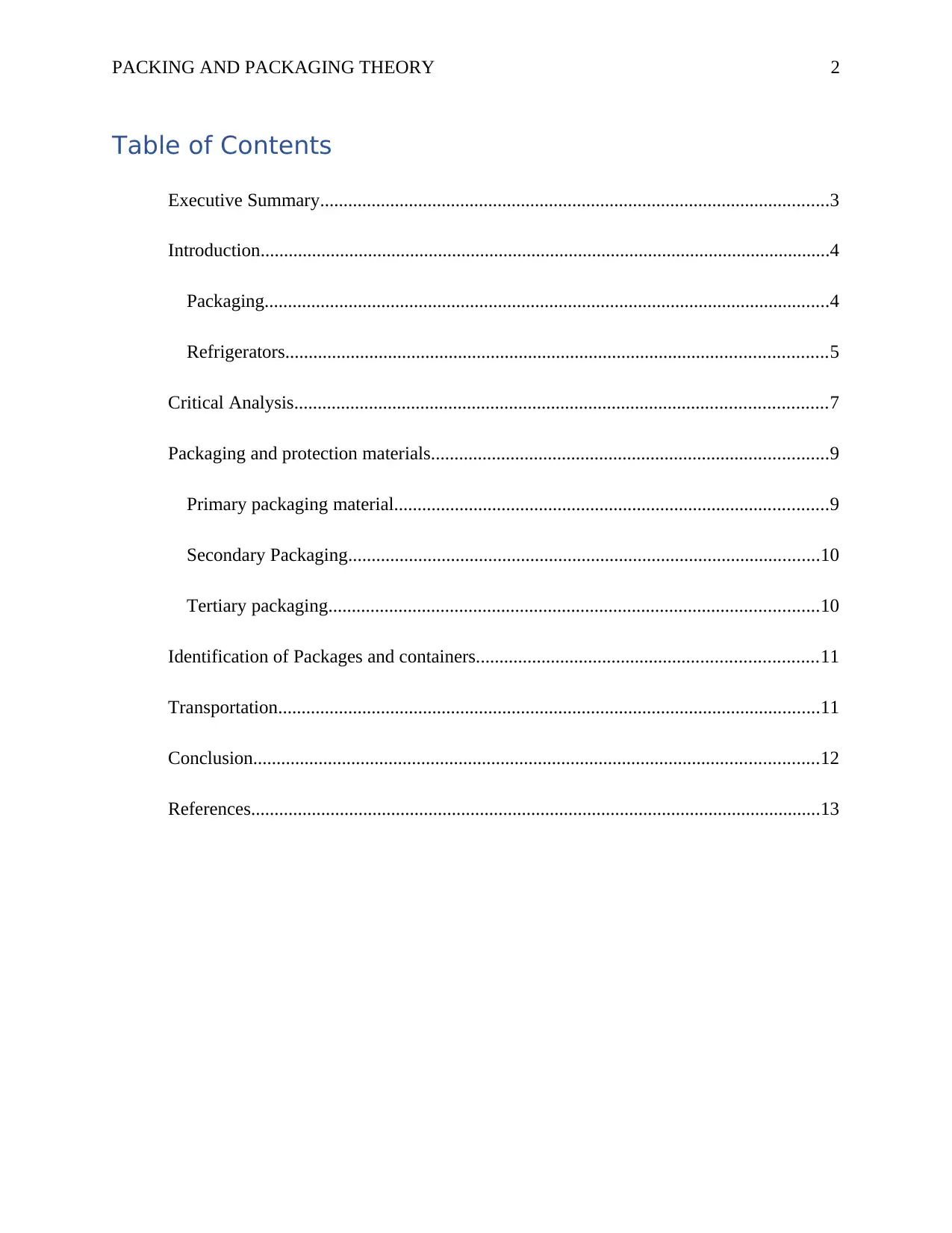
PACKING AND PACKAGING THEORY 2
Table of Contents
Executive Summary.............................................................................................................3
Introduction..........................................................................................................................4
Packaging.........................................................................................................................4
Refrigerators....................................................................................................................5
Critical Analysis..................................................................................................................7
Packaging and protection materials.....................................................................................9
Primary packaging material.............................................................................................9
Secondary Packaging.....................................................................................................10
Tertiary packaging.........................................................................................................10
Identification of Packages and containers.........................................................................11
Transportation....................................................................................................................11
Conclusion.........................................................................................................................12
References..........................................................................................................................13
Table of Contents
Executive Summary.............................................................................................................3
Introduction..........................................................................................................................4
Packaging.........................................................................................................................4
Refrigerators....................................................................................................................5
Critical Analysis..................................................................................................................7
Packaging and protection materials.....................................................................................9
Primary packaging material.............................................................................................9
Secondary Packaging.....................................................................................................10
Tertiary packaging.........................................................................................................10
Identification of Packages and containers.........................................................................11
Transportation....................................................................................................................11
Conclusion.........................................................................................................................12
References..........................................................................................................................13
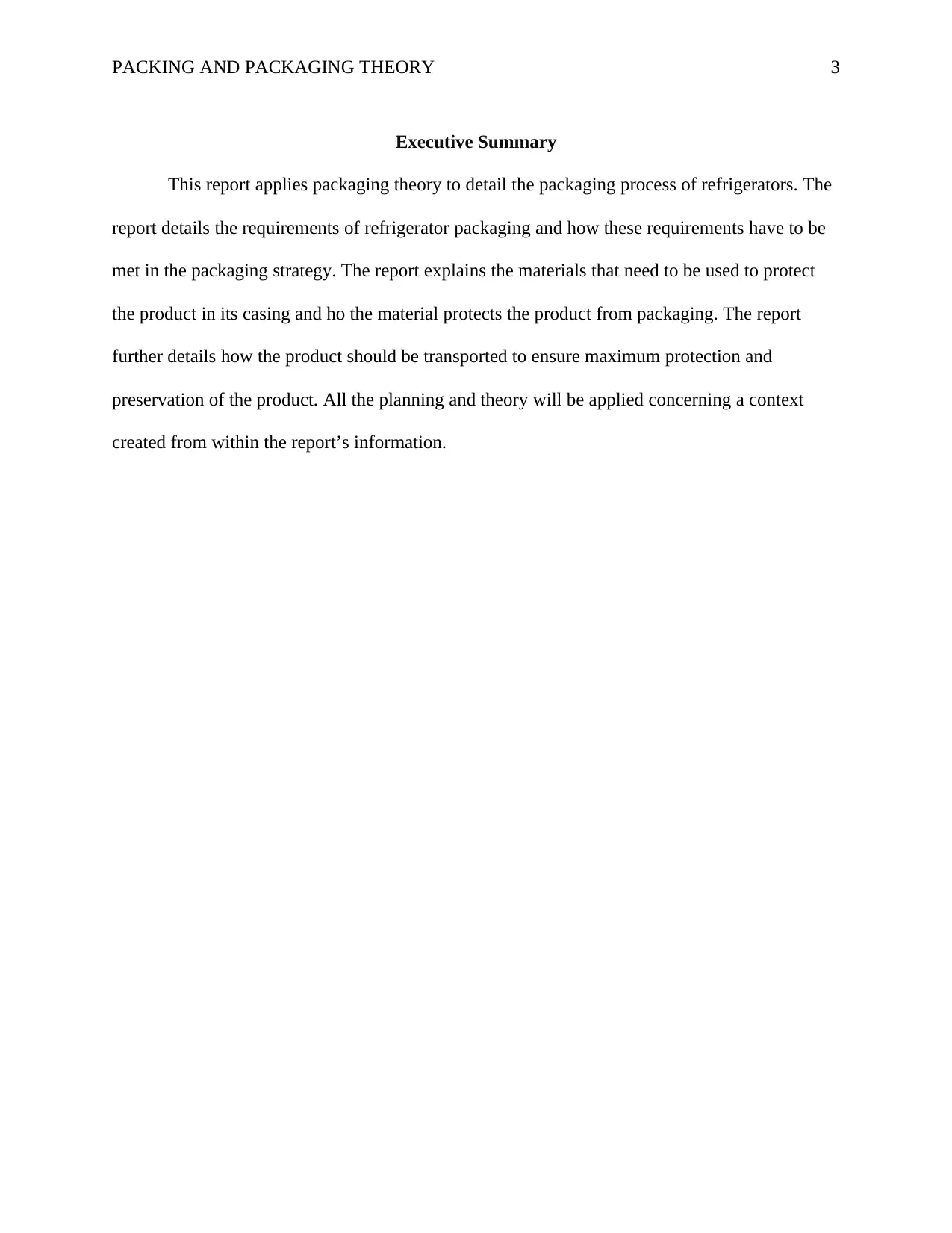
PACKING AND PACKAGING THEORY 3
Executive Summary
This report applies packaging theory to detail the packaging process of refrigerators. The
report details the requirements of refrigerator packaging and how these requirements have to be
met in the packaging strategy. The report explains the materials that need to be used to protect
the product in its casing and ho the material protects the product from packaging. The report
further details how the product should be transported to ensure maximum protection and
preservation of the product. All the planning and theory will be applied concerning a context
created from within the report’s information.
Executive Summary
This report applies packaging theory to detail the packaging process of refrigerators. The
report details the requirements of refrigerator packaging and how these requirements have to be
met in the packaging strategy. The report explains the materials that need to be used to protect
the product in its casing and ho the material protects the product from packaging. The report
further details how the product should be transported to ensure maximum protection and
preservation of the product. All the planning and theory will be applied concerning a context
created from within the report’s information.
⊘ This is a preview!⊘
Do you want full access?
Subscribe today to unlock all pages.

Trusted by 1+ million students worldwide
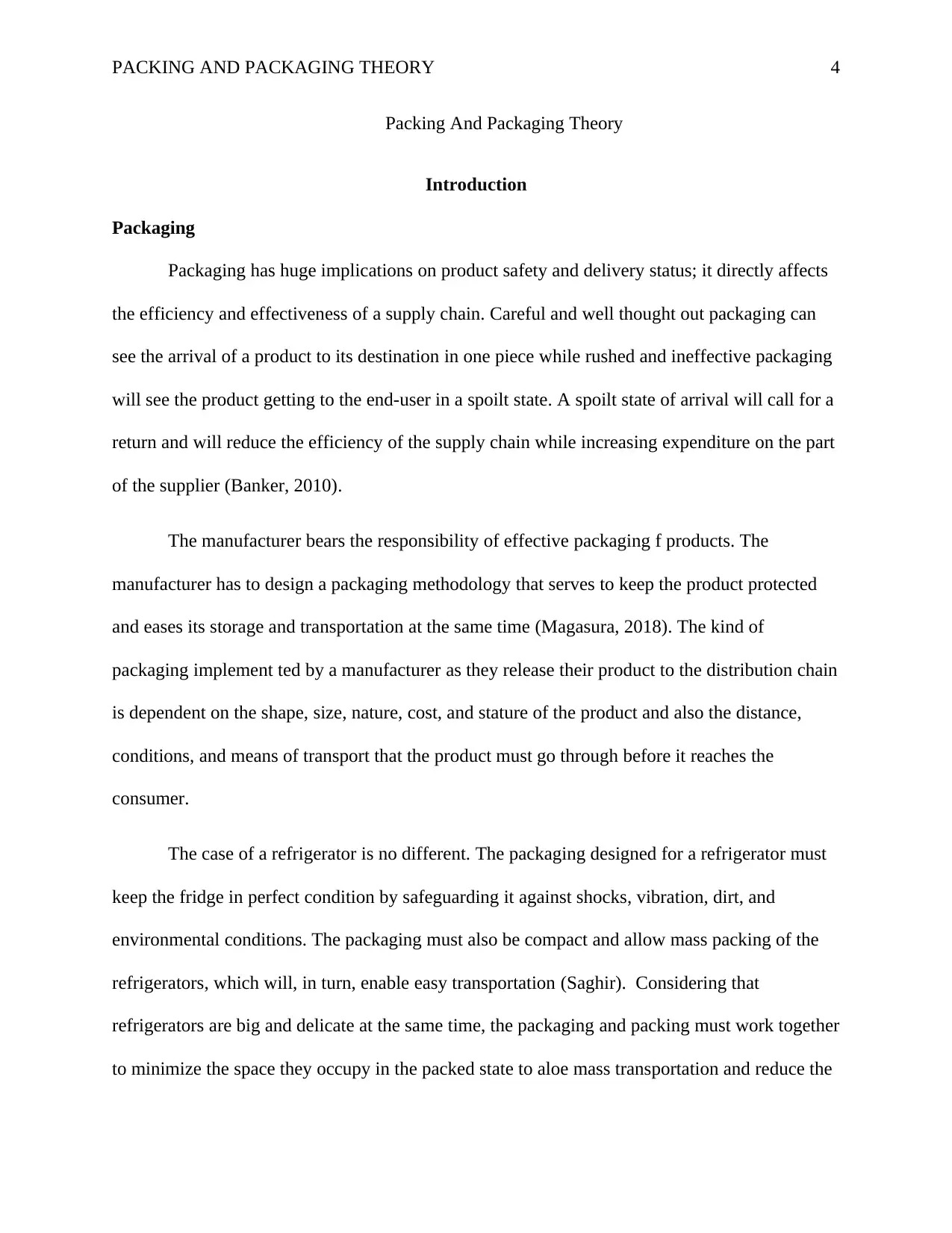
PACKING AND PACKAGING THEORY 4
Packing And Packaging Theory
Introduction
Packaging
Packaging has huge implications on product safety and delivery status; it directly affects
the efficiency and effectiveness of a supply chain. Careful and well thought out packaging can
see the arrival of a product to its destination in one piece while rushed and ineffective packaging
will see the product getting to the end-user in a spoilt state. A spoilt state of arrival will call for a
return and will reduce the efficiency of the supply chain while increasing expenditure on the part
of the supplier (Banker, 2010).
The manufacturer bears the responsibility of effective packaging f products. The
manufacturer has to design a packaging methodology that serves to keep the product protected
and eases its storage and transportation at the same time (Magasura, 2018). The kind of
packaging implement ted by a manufacturer as they release their product to the distribution chain
is dependent on the shape, size, nature, cost, and stature of the product and also the distance,
conditions, and means of transport that the product must go through before it reaches the
consumer.
The case of a refrigerator is no different. The packaging designed for a refrigerator must
keep the fridge in perfect condition by safeguarding it against shocks, vibration, dirt, and
environmental conditions. The packaging must also be compact and allow mass packing of the
refrigerators, which will, in turn, enable easy transportation (Saghir). Considering that
refrigerators are big and delicate at the same time, the packaging and packing must work together
to minimize the space they occupy in the packed state to aloe mass transportation and reduce the
Packing And Packaging Theory
Introduction
Packaging
Packaging has huge implications on product safety and delivery status; it directly affects
the efficiency and effectiveness of a supply chain. Careful and well thought out packaging can
see the arrival of a product to its destination in one piece while rushed and ineffective packaging
will see the product getting to the end-user in a spoilt state. A spoilt state of arrival will call for a
return and will reduce the efficiency of the supply chain while increasing expenditure on the part
of the supplier (Banker, 2010).
The manufacturer bears the responsibility of effective packaging f products. The
manufacturer has to design a packaging methodology that serves to keep the product protected
and eases its storage and transportation at the same time (Magasura, 2018). The kind of
packaging implement ted by a manufacturer as they release their product to the distribution chain
is dependent on the shape, size, nature, cost, and stature of the product and also the distance,
conditions, and means of transport that the product must go through before it reaches the
consumer.
The case of a refrigerator is no different. The packaging designed for a refrigerator must
keep the fridge in perfect condition by safeguarding it against shocks, vibration, dirt, and
environmental conditions. The packaging must also be compact and allow mass packing of the
refrigerators, which will, in turn, enable easy transportation (Saghir). Considering that
refrigerators are big and delicate at the same time, the packaging and packing must work together
to minimize the space they occupy in the packed state to aloe mass transportation and reduce the
Paraphrase This Document
Need a fresh take? Get an instant paraphrase of this document with our AI Paraphraser
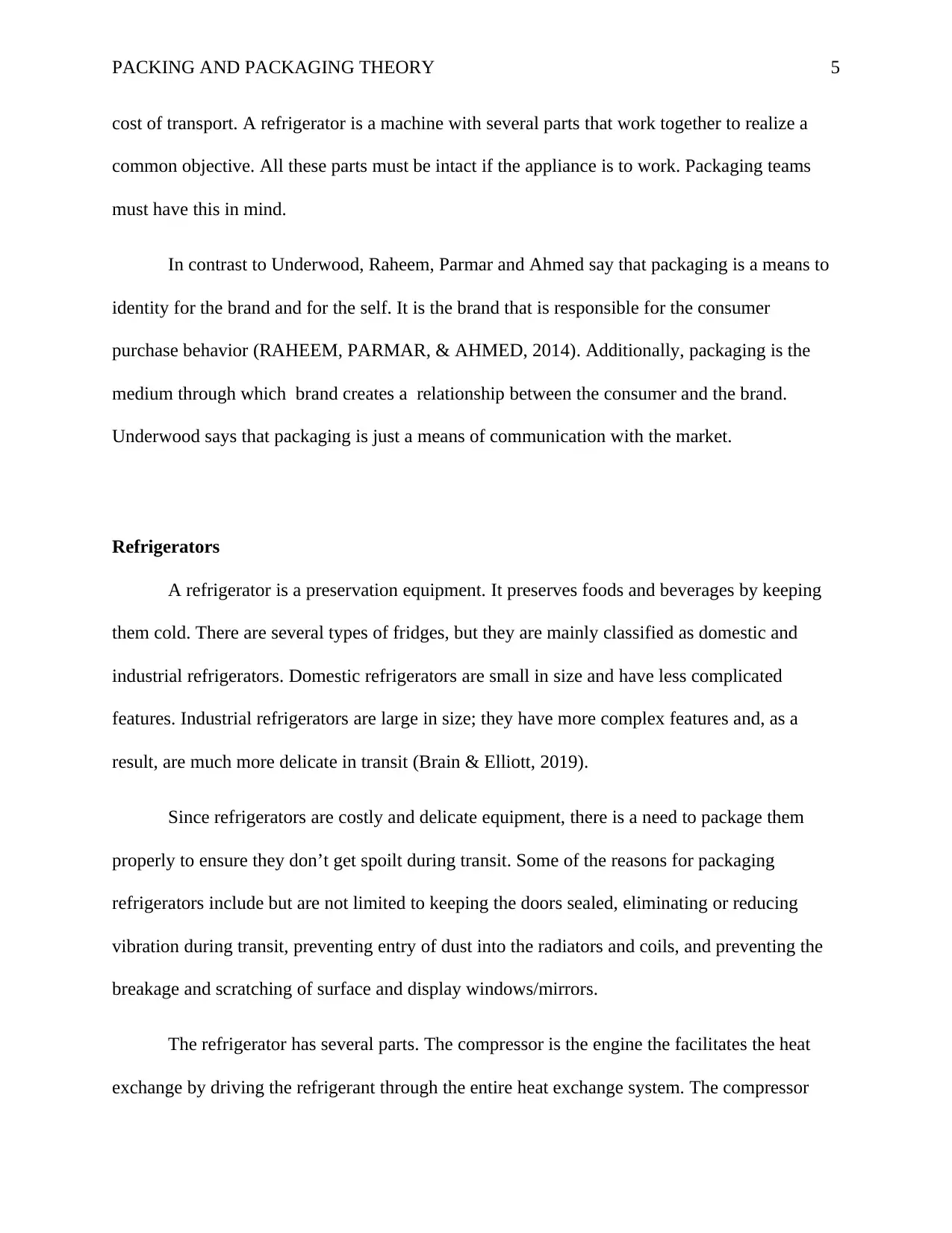
PACKING AND PACKAGING THEORY 5
cost of transport. A refrigerator is a machine with several parts that work together to realize a
common objective. All these parts must be intact if the appliance is to work. Packaging teams
must have this in mind.
In contrast to Underwood, Raheem, Parmar and Ahmed say that packaging is a means to
identity for the brand and for the self. It is the brand that is responsible for the consumer
purchase behavior (RAHEEM, PARMAR, & AHMED, 2014). Additionally, packaging is the
medium through which brand creates a relationship between the consumer and the brand.
Underwood says that packaging is just a means of communication with the market.
Refrigerators
A refrigerator is a preservation equipment. It preserves foods and beverages by keeping
them cold. There are several types of fridges, but they are mainly classified as domestic and
industrial refrigerators. Domestic refrigerators are small in size and have less complicated
features. Industrial refrigerators are large in size; they have more complex features and, as a
result, are much more delicate in transit (Brain & Elliott, 2019).
Since refrigerators are costly and delicate equipment, there is a need to package them
properly to ensure they don’t get spoilt during transit. Some of the reasons for packaging
refrigerators include but are not limited to keeping the doors sealed, eliminating or reducing
vibration during transit, preventing entry of dust into the radiators and coils, and preventing the
breakage and scratching of surface and display windows/mirrors.
The refrigerator has several parts. The compressor is the engine the facilitates the heat
exchange by driving the refrigerant through the entire heat exchange system. The compressor
cost of transport. A refrigerator is a machine with several parts that work together to realize a
common objective. All these parts must be intact if the appliance is to work. Packaging teams
must have this in mind.
In contrast to Underwood, Raheem, Parmar and Ahmed say that packaging is a means to
identity for the brand and for the self. It is the brand that is responsible for the consumer
purchase behavior (RAHEEM, PARMAR, & AHMED, 2014). Additionally, packaging is the
medium through which brand creates a relationship between the consumer and the brand.
Underwood says that packaging is just a means of communication with the market.
Refrigerators
A refrigerator is a preservation equipment. It preserves foods and beverages by keeping
them cold. There are several types of fridges, but they are mainly classified as domestic and
industrial refrigerators. Domestic refrigerators are small in size and have less complicated
features. Industrial refrigerators are large in size; they have more complex features and, as a
result, are much more delicate in transit (Brain & Elliott, 2019).
Since refrigerators are costly and delicate equipment, there is a need to package them
properly to ensure they don’t get spoilt during transit. Some of the reasons for packaging
refrigerators include but are not limited to keeping the doors sealed, eliminating or reducing
vibration during transit, preventing entry of dust into the radiators and coils, and preventing the
breakage and scratching of surface and display windows/mirrors.
The refrigerator has several parts. The compressor is the engine the facilitates the heat
exchange by driving the refrigerant through the entire heat exchange system. The compressor
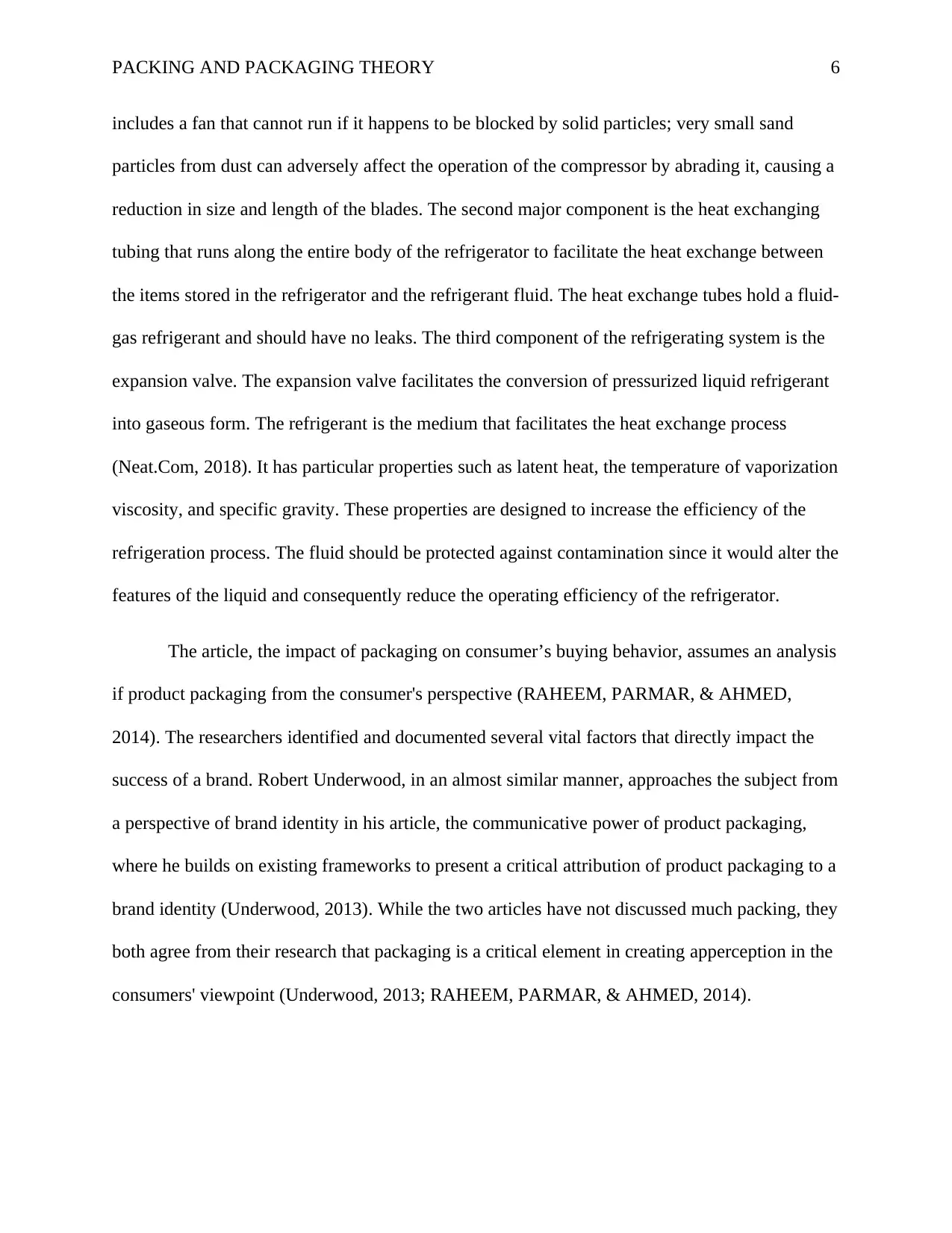
PACKING AND PACKAGING THEORY 6
includes a fan that cannot run if it happens to be blocked by solid particles; very small sand
particles from dust can adversely affect the operation of the compressor by abrading it, causing a
reduction in size and length of the blades. The second major component is the heat exchanging
tubing that runs along the entire body of the refrigerator to facilitate the heat exchange between
the items stored in the refrigerator and the refrigerant fluid. The heat exchange tubes hold a fluid-
gas refrigerant and should have no leaks. The third component of the refrigerating system is the
expansion valve. The expansion valve facilitates the conversion of pressurized liquid refrigerant
into gaseous form. The refrigerant is the medium that facilitates the heat exchange process
(Neat.Com, 2018). It has particular properties such as latent heat, the temperature of vaporization
viscosity, and specific gravity. These properties are designed to increase the efficiency of the
refrigeration process. The fluid should be protected against contamination since it would alter the
features of the liquid and consequently reduce the operating efficiency of the refrigerator.
The article, the impact of packaging on consumer’s buying behavior, assumes an analysis
if product packaging from the consumer's perspective (RAHEEM, PARMAR, & AHMED,
2014). The researchers identified and documented several vital factors that directly impact the
success of a brand. Robert Underwood, in an almost similar manner, approaches the subject from
a perspective of brand identity in his article, the communicative power of product packaging,
where he builds on existing frameworks to present a critical attribution of product packaging to a
brand identity (Underwood, 2013). While the two articles have not discussed much packing, they
both agree from their research that packaging is a critical element in creating apperception in the
consumers' viewpoint (Underwood, 2013; RAHEEM, PARMAR, & AHMED, 2014).
includes a fan that cannot run if it happens to be blocked by solid particles; very small sand
particles from dust can adversely affect the operation of the compressor by abrading it, causing a
reduction in size and length of the blades. The second major component is the heat exchanging
tubing that runs along the entire body of the refrigerator to facilitate the heat exchange between
the items stored in the refrigerator and the refrigerant fluid. The heat exchange tubes hold a fluid-
gas refrigerant and should have no leaks. The third component of the refrigerating system is the
expansion valve. The expansion valve facilitates the conversion of pressurized liquid refrigerant
into gaseous form. The refrigerant is the medium that facilitates the heat exchange process
(Neat.Com, 2018). It has particular properties such as latent heat, the temperature of vaporization
viscosity, and specific gravity. These properties are designed to increase the efficiency of the
refrigeration process. The fluid should be protected against contamination since it would alter the
features of the liquid and consequently reduce the operating efficiency of the refrigerator.
The article, the impact of packaging on consumer’s buying behavior, assumes an analysis
if product packaging from the consumer's perspective (RAHEEM, PARMAR, & AHMED,
2014). The researchers identified and documented several vital factors that directly impact the
success of a brand. Robert Underwood, in an almost similar manner, approaches the subject from
a perspective of brand identity in his article, the communicative power of product packaging,
where he builds on existing frameworks to present a critical attribution of product packaging to a
brand identity (Underwood, 2013). While the two articles have not discussed much packing, they
both agree from their research that packaging is a critical element in creating apperception in the
consumers' viewpoint (Underwood, 2013; RAHEEM, PARMAR, & AHMED, 2014).
⊘ This is a preview!⊘
Do you want full access?
Subscribe today to unlock all pages.

Trusted by 1+ million students worldwide
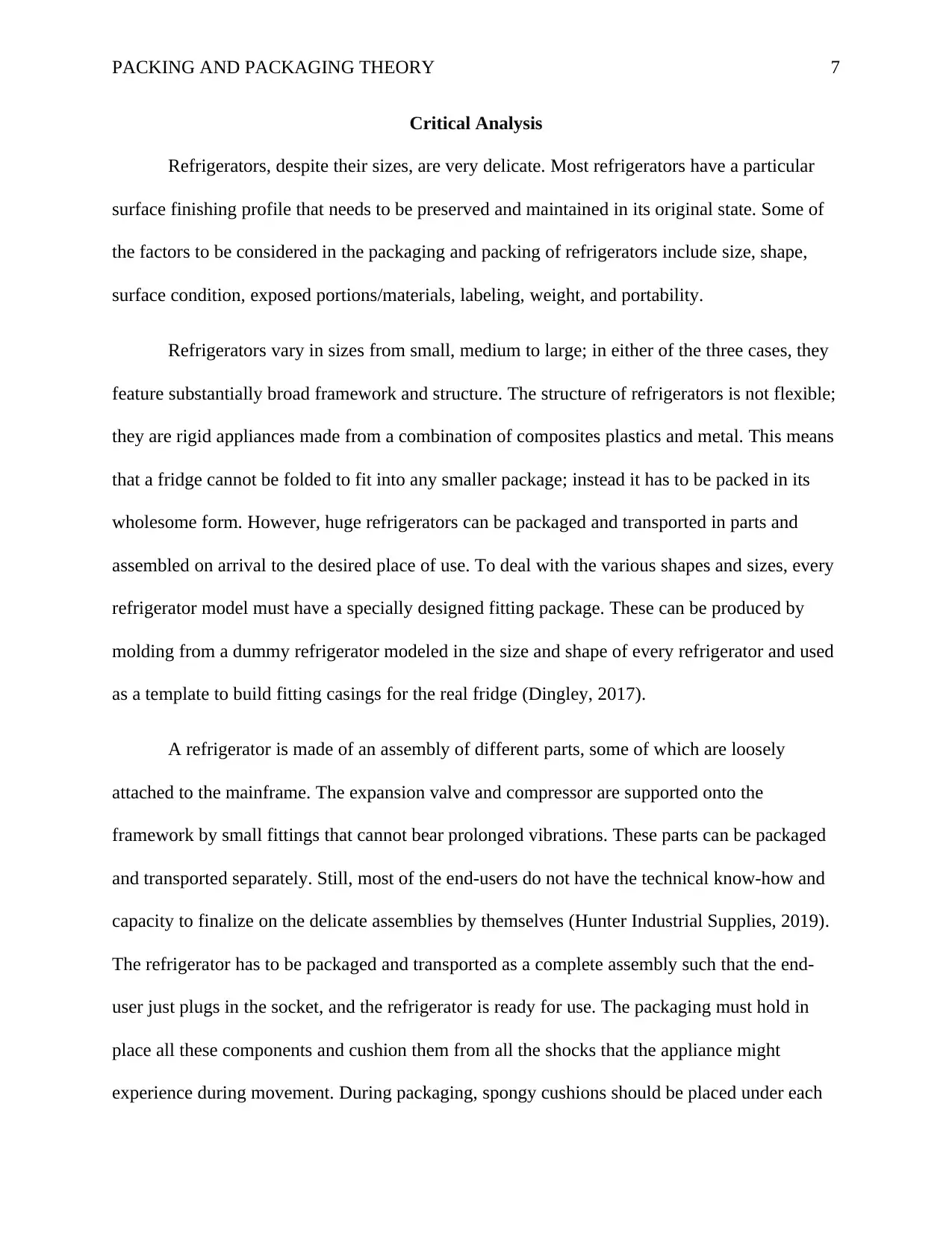
PACKING AND PACKAGING THEORY 7
Critical Analysis
Refrigerators, despite their sizes, are very delicate. Most refrigerators have a particular
surface finishing profile that needs to be preserved and maintained in its original state. Some of
the factors to be considered in the packaging and packing of refrigerators include size, shape,
surface condition, exposed portions/materials, labeling, weight, and portability.
Refrigerators vary in sizes from small, medium to large; in either of the three cases, they
feature substantially broad framework and structure. The structure of refrigerators is not flexible;
they are rigid appliances made from a combination of composites plastics and metal. This means
that a fridge cannot be folded to fit into any smaller package; instead it has to be packed in its
wholesome form. However, huge refrigerators can be packaged and transported in parts and
assembled on arrival to the desired place of use. To deal with the various shapes and sizes, every
refrigerator model must have a specially designed fitting package. These can be produced by
molding from a dummy refrigerator modeled in the size and shape of every refrigerator and used
as a template to build fitting casings for the real fridge (Dingley, 2017).
A refrigerator is made of an assembly of different parts, some of which are loosely
attached to the mainframe. The expansion valve and compressor are supported onto the
framework by small fittings that cannot bear prolonged vibrations. These parts can be packaged
and transported separately. Still, most of the end-users do not have the technical know-how and
capacity to finalize on the delicate assemblies by themselves (Hunter Industrial Supplies, 2019).
The refrigerator has to be packaged and transported as a complete assembly such that the end-
user just plugs in the socket, and the refrigerator is ready for use. The packaging must hold in
place all these components and cushion them from all the shocks that the appliance might
experience during movement. During packaging, spongy cushions should be placed under each
Critical Analysis
Refrigerators, despite their sizes, are very delicate. Most refrigerators have a particular
surface finishing profile that needs to be preserved and maintained in its original state. Some of
the factors to be considered in the packaging and packing of refrigerators include size, shape,
surface condition, exposed portions/materials, labeling, weight, and portability.
Refrigerators vary in sizes from small, medium to large; in either of the three cases, they
feature substantially broad framework and structure. The structure of refrigerators is not flexible;
they are rigid appliances made from a combination of composites plastics and metal. This means
that a fridge cannot be folded to fit into any smaller package; instead it has to be packed in its
wholesome form. However, huge refrigerators can be packaged and transported in parts and
assembled on arrival to the desired place of use. To deal with the various shapes and sizes, every
refrigerator model must have a specially designed fitting package. These can be produced by
molding from a dummy refrigerator modeled in the size and shape of every refrigerator and used
as a template to build fitting casings for the real fridge (Dingley, 2017).
A refrigerator is made of an assembly of different parts, some of which are loosely
attached to the mainframe. The expansion valve and compressor are supported onto the
framework by small fittings that cannot bear prolonged vibrations. These parts can be packaged
and transported separately. Still, most of the end-users do not have the technical know-how and
capacity to finalize on the delicate assemblies by themselves (Hunter Industrial Supplies, 2019).
The refrigerator has to be packaged and transported as a complete assembly such that the end-
user just plugs in the socket, and the refrigerator is ready for use. The packaging must hold in
place all these components and cushion them from all the shocks that the appliance might
experience during movement. During packaging, spongy cushions should be placed under each
Paraphrase This Document
Need a fresh take? Get an instant paraphrase of this document with our AI Paraphraser
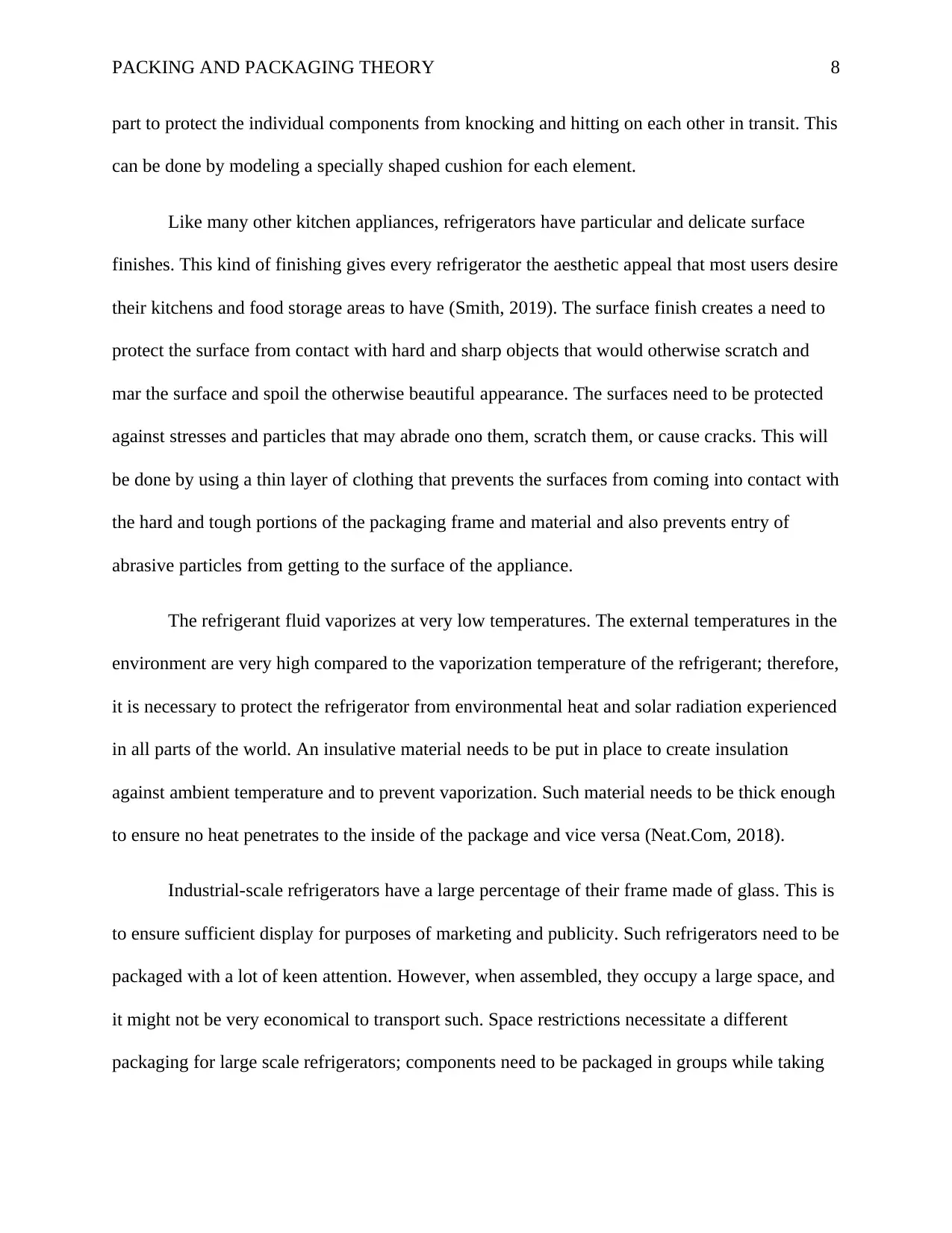
PACKING AND PACKAGING THEORY 8
part to protect the individual components from knocking and hitting on each other in transit. This
can be done by modeling a specially shaped cushion for each element.
Like many other kitchen appliances, refrigerators have particular and delicate surface
finishes. This kind of finishing gives every refrigerator the aesthetic appeal that most users desire
their kitchens and food storage areas to have (Smith, 2019). The surface finish creates a need to
protect the surface from contact with hard and sharp objects that would otherwise scratch and
mar the surface and spoil the otherwise beautiful appearance. The surfaces need to be protected
against stresses and particles that may abrade ono them, scratch them, or cause cracks. This will
be done by using a thin layer of clothing that prevents the surfaces from coming into contact with
the hard and tough portions of the packaging frame and material and also prevents entry of
abrasive particles from getting to the surface of the appliance.
The refrigerant fluid vaporizes at very low temperatures. The external temperatures in the
environment are very high compared to the vaporization temperature of the refrigerant; therefore,
it is necessary to protect the refrigerator from environmental heat and solar radiation experienced
in all parts of the world. An insulative material needs to be put in place to create insulation
against ambient temperature and to prevent vaporization. Such material needs to be thick enough
to ensure no heat penetrates to the inside of the package and vice versa (Neat.Com, 2018).
Industrial-scale refrigerators have a large percentage of their frame made of glass. This is
to ensure sufficient display for purposes of marketing and publicity. Such refrigerators need to be
packaged with a lot of keen attention. However, when assembled, they occupy a large space, and
it might not be very economical to transport such. Space restrictions necessitate a different
packaging for large scale refrigerators; components need to be packaged in groups while taking
part to protect the individual components from knocking and hitting on each other in transit. This
can be done by modeling a specially shaped cushion for each element.
Like many other kitchen appliances, refrigerators have particular and delicate surface
finishes. This kind of finishing gives every refrigerator the aesthetic appeal that most users desire
their kitchens and food storage areas to have (Smith, 2019). The surface finish creates a need to
protect the surface from contact with hard and sharp objects that would otherwise scratch and
mar the surface and spoil the otherwise beautiful appearance. The surfaces need to be protected
against stresses and particles that may abrade ono them, scratch them, or cause cracks. This will
be done by using a thin layer of clothing that prevents the surfaces from coming into contact with
the hard and tough portions of the packaging frame and material and also prevents entry of
abrasive particles from getting to the surface of the appliance.
The refrigerant fluid vaporizes at very low temperatures. The external temperatures in the
environment are very high compared to the vaporization temperature of the refrigerant; therefore,
it is necessary to protect the refrigerator from environmental heat and solar radiation experienced
in all parts of the world. An insulative material needs to be put in place to create insulation
against ambient temperature and to prevent vaporization. Such material needs to be thick enough
to ensure no heat penetrates to the inside of the package and vice versa (Neat.Com, 2018).
Industrial-scale refrigerators have a large percentage of their frame made of glass. This is
to ensure sufficient display for purposes of marketing and publicity. Such refrigerators need to be
packaged with a lot of keen attention. However, when assembled, they occupy a large space, and
it might not be very economical to transport such. Space restrictions necessitate a different
packaging for large scale refrigerators; components need to be packaged in groups while taking
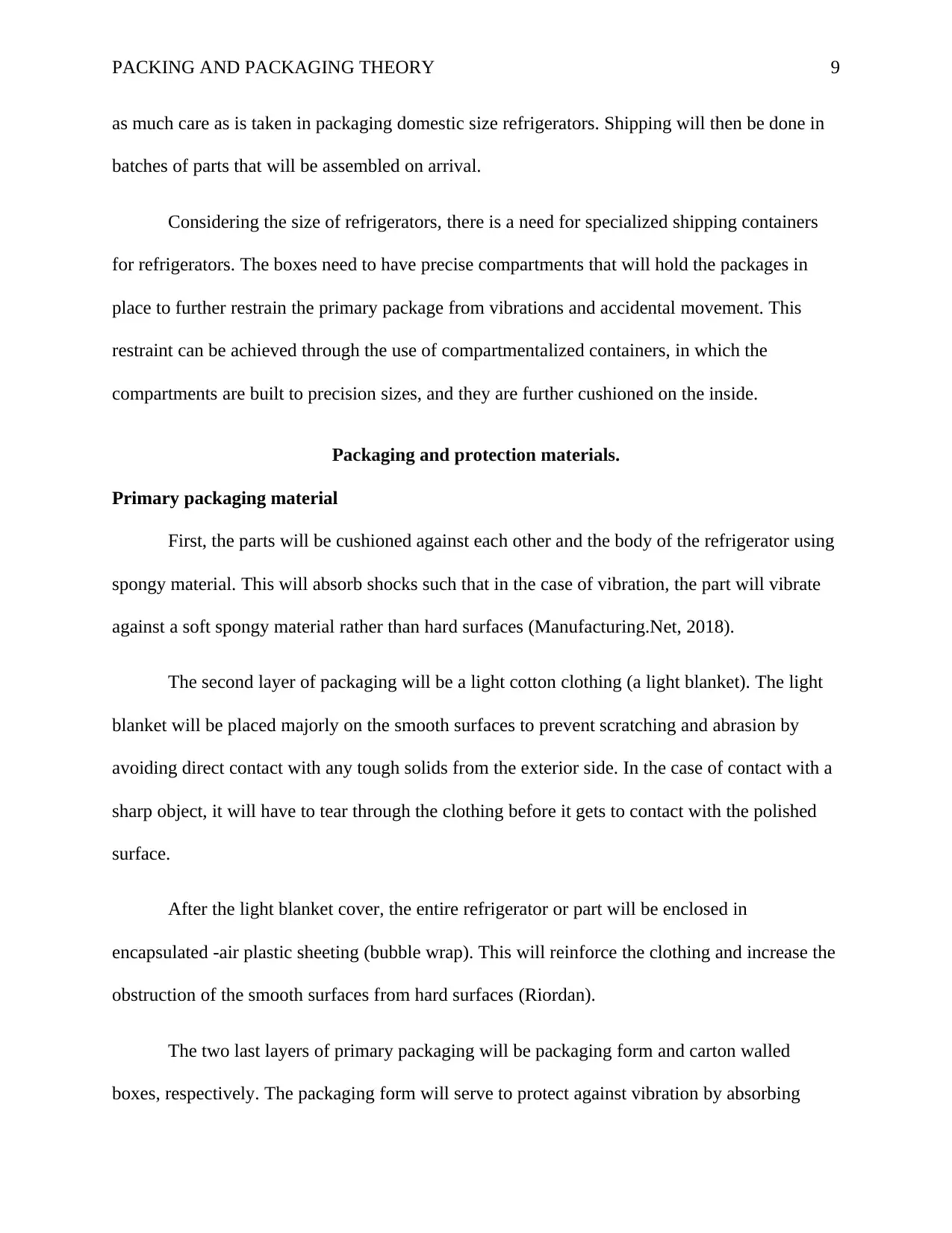
PACKING AND PACKAGING THEORY 9
as much care as is taken in packaging domestic size refrigerators. Shipping will then be done in
batches of parts that will be assembled on arrival.
Considering the size of refrigerators, there is a need for specialized shipping containers
for refrigerators. The boxes need to have precise compartments that will hold the packages in
place to further restrain the primary package from vibrations and accidental movement. This
restraint can be achieved through the use of compartmentalized containers, in which the
compartments are built to precision sizes, and they are further cushioned on the inside.
Packaging and protection materials.
Primary packaging material
First, the parts will be cushioned against each other and the body of the refrigerator using
spongy material. This will absorb shocks such that in the case of vibration, the part will vibrate
against a soft spongy material rather than hard surfaces (Manufacturing.Net, 2018).
The second layer of packaging will be a light cotton clothing (a light blanket). The light
blanket will be placed majorly on the smooth surfaces to prevent scratching and abrasion by
avoiding direct contact with any tough solids from the exterior side. In the case of contact with a
sharp object, it will have to tear through the clothing before it gets to contact with the polished
surface.
After the light blanket cover, the entire refrigerator or part will be enclosed in
encapsulated -air plastic sheeting (bubble wrap). This will reinforce the clothing and increase the
obstruction of the smooth surfaces from hard surfaces (Riordan).
The two last layers of primary packaging will be packaging form and carton walled
boxes, respectively. The packaging form will serve to protect against vibration by absorbing
as much care as is taken in packaging domestic size refrigerators. Shipping will then be done in
batches of parts that will be assembled on arrival.
Considering the size of refrigerators, there is a need for specialized shipping containers
for refrigerators. The boxes need to have precise compartments that will hold the packages in
place to further restrain the primary package from vibrations and accidental movement. This
restraint can be achieved through the use of compartmentalized containers, in which the
compartments are built to precision sizes, and they are further cushioned on the inside.
Packaging and protection materials.
Primary packaging material
First, the parts will be cushioned against each other and the body of the refrigerator using
spongy material. This will absorb shocks such that in the case of vibration, the part will vibrate
against a soft spongy material rather than hard surfaces (Manufacturing.Net, 2018).
The second layer of packaging will be a light cotton clothing (a light blanket). The light
blanket will be placed majorly on the smooth surfaces to prevent scratching and abrasion by
avoiding direct contact with any tough solids from the exterior side. In the case of contact with a
sharp object, it will have to tear through the clothing before it gets to contact with the polished
surface.
After the light blanket cover, the entire refrigerator or part will be enclosed in
encapsulated -air plastic sheeting (bubble wrap). This will reinforce the clothing and increase the
obstruction of the smooth surfaces from hard surfaces (Riordan).
The two last layers of primary packaging will be packaging form and carton walled
boxes, respectively. The packaging form will serve to protect against vibration by absorbing
⊘ This is a preview!⊘
Do you want full access?
Subscribe today to unlock all pages.

Trusted by 1+ million students worldwide
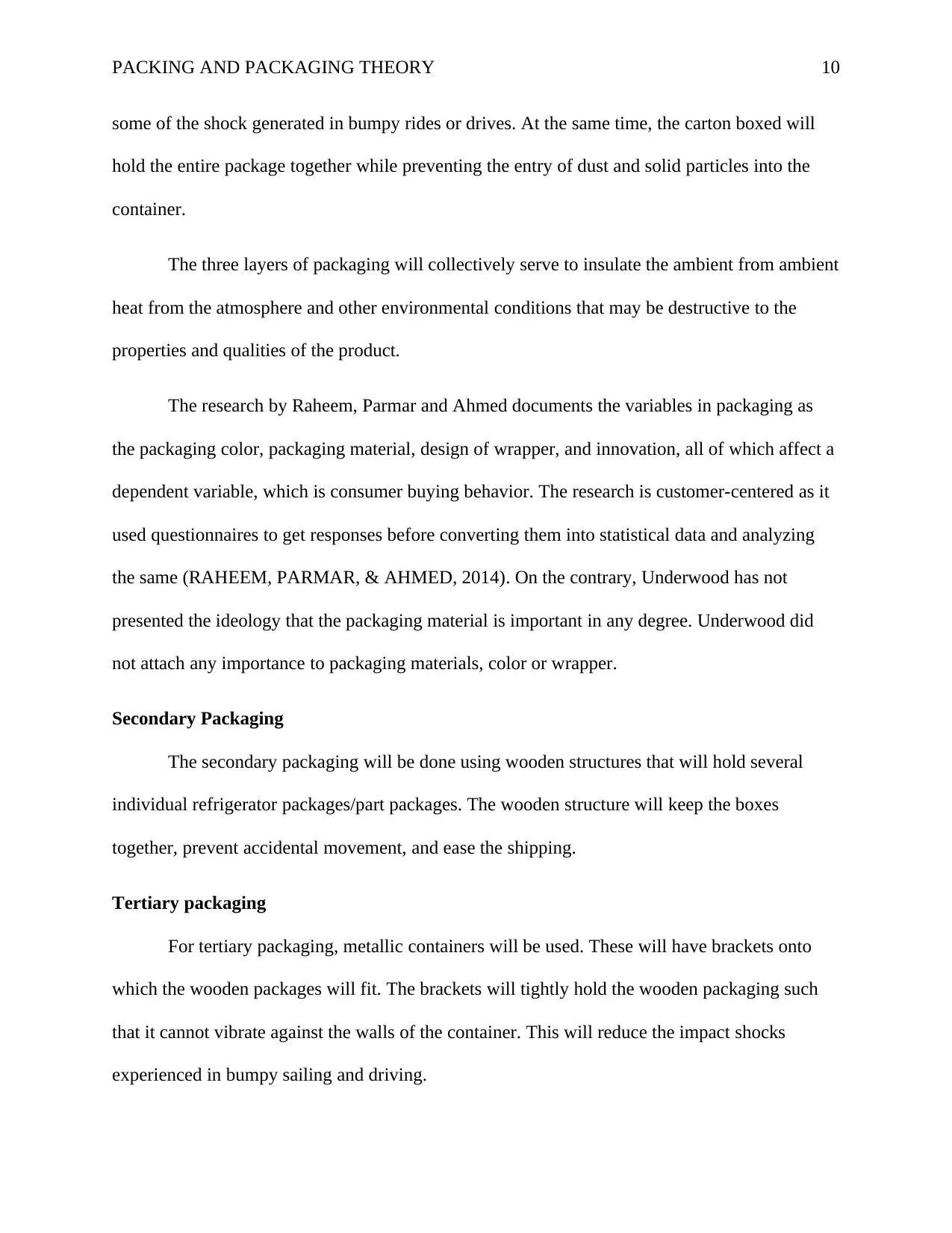
PACKING AND PACKAGING THEORY 10
some of the shock generated in bumpy rides or drives. At the same time, the carton boxed will
hold the entire package together while preventing the entry of dust and solid particles into the
container.
The three layers of packaging will collectively serve to insulate the ambient from ambient
heat from the atmosphere and other environmental conditions that may be destructive to the
properties and qualities of the product.
The research by Raheem, Parmar and Ahmed documents the variables in packaging as
the packaging color, packaging material, design of wrapper, and innovation, all of which affect a
dependent variable, which is consumer buying behavior. The research is customer-centered as it
used questionnaires to get responses before converting them into statistical data and analyzing
the same (RAHEEM, PARMAR, & AHMED, 2014). On the contrary, Underwood has not
presented the ideology that the packaging material is important in any degree. Underwood did
not attach any importance to packaging materials, color or wrapper.
Secondary Packaging
The secondary packaging will be done using wooden structures that will hold several
individual refrigerator packages/part packages. The wooden structure will keep the boxes
together, prevent accidental movement, and ease the shipping.
Tertiary packaging
For tertiary packaging, metallic containers will be used. These will have brackets onto
which the wooden packages will fit. The brackets will tightly hold the wooden packaging such
that it cannot vibrate against the walls of the container. This will reduce the impact shocks
experienced in bumpy sailing and driving.
some of the shock generated in bumpy rides or drives. At the same time, the carton boxed will
hold the entire package together while preventing the entry of dust and solid particles into the
container.
The three layers of packaging will collectively serve to insulate the ambient from ambient
heat from the atmosphere and other environmental conditions that may be destructive to the
properties and qualities of the product.
The research by Raheem, Parmar and Ahmed documents the variables in packaging as
the packaging color, packaging material, design of wrapper, and innovation, all of which affect a
dependent variable, which is consumer buying behavior. The research is customer-centered as it
used questionnaires to get responses before converting them into statistical data and analyzing
the same (RAHEEM, PARMAR, & AHMED, 2014). On the contrary, Underwood has not
presented the ideology that the packaging material is important in any degree. Underwood did
not attach any importance to packaging materials, color or wrapper.
Secondary Packaging
The secondary packaging will be done using wooden structures that will hold several
individual refrigerator packages/part packages. The wooden structure will keep the boxes
together, prevent accidental movement, and ease the shipping.
Tertiary packaging
For tertiary packaging, metallic containers will be used. These will have brackets onto
which the wooden packages will fit. The brackets will tightly hold the wooden packaging such
that it cannot vibrate against the walls of the container. This will reduce the impact shocks
experienced in bumpy sailing and driving.
Paraphrase This Document
Need a fresh take? Get an instant paraphrase of this document with our AI Paraphraser
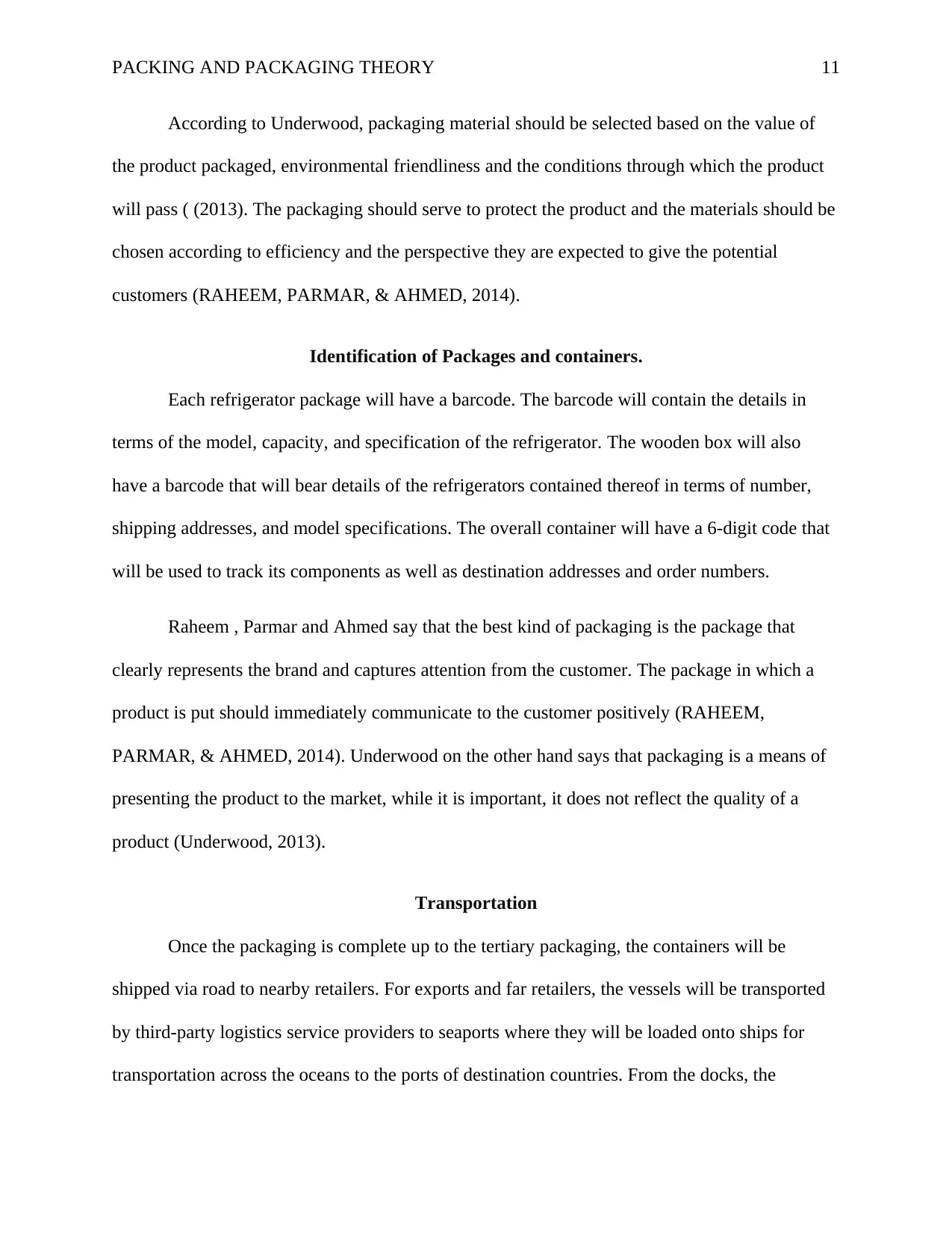
PACKING AND PACKAGING THEORY 11
According to Underwood, packaging material should be selected based on the value of
the product packaged, environmental friendliness and the conditions through which the product
will pass ( (2013). The packaging should serve to protect the product and the materials should be
chosen according to efficiency and the perspective they are expected to give the potential
customers (RAHEEM, PARMAR, & AHMED, 2014).
Identification of Packages and containers.
Each refrigerator package will have a barcode. The barcode will contain the details in
terms of the model, capacity, and specification of the refrigerator. The wooden box will also
have a barcode that will bear details of the refrigerators contained thereof in terms of number,
shipping addresses, and model specifications. The overall container will have a 6-digit code that
will be used to track its components as well as destination addresses and order numbers.
Raheem , Parmar and Ahmed say that the best kind of packaging is the package that
clearly represents the brand and captures attention from the customer. The package in which a
product is put should immediately communicate to the customer positively (RAHEEM,
PARMAR, & AHMED, 2014). Underwood on the other hand says that packaging is a means of
presenting the product to the market, while it is important, it does not reflect the quality of a
product (Underwood, 2013).
Transportation
Once the packaging is complete up to the tertiary packaging, the containers will be
shipped via road to nearby retailers. For exports and far retailers, the vessels will be transported
by third-party logistics service providers to seaports where they will be loaded onto ships for
transportation across the oceans to the ports of destination countries. From the docks, the
According to Underwood, packaging material should be selected based on the value of
the product packaged, environmental friendliness and the conditions through which the product
will pass ( (2013). The packaging should serve to protect the product and the materials should be
chosen according to efficiency and the perspective they are expected to give the potential
customers (RAHEEM, PARMAR, & AHMED, 2014).
Identification of Packages and containers.
Each refrigerator package will have a barcode. The barcode will contain the details in
terms of the model, capacity, and specification of the refrigerator. The wooden box will also
have a barcode that will bear details of the refrigerators contained thereof in terms of number,
shipping addresses, and model specifications. The overall container will have a 6-digit code that
will be used to track its components as well as destination addresses and order numbers.
Raheem , Parmar and Ahmed say that the best kind of packaging is the package that
clearly represents the brand and captures attention from the customer. The package in which a
product is put should immediately communicate to the customer positively (RAHEEM,
PARMAR, & AHMED, 2014). Underwood on the other hand says that packaging is a means of
presenting the product to the market, while it is important, it does not reflect the quality of a
product (Underwood, 2013).
Transportation
Once the packaging is complete up to the tertiary packaging, the containers will be
shipped via road to nearby retailers. For exports and far retailers, the vessels will be transported
by third-party logistics service providers to seaports where they will be loaded onto ships for
transportation across the oceans to the ports of destination countries. From the docks, the
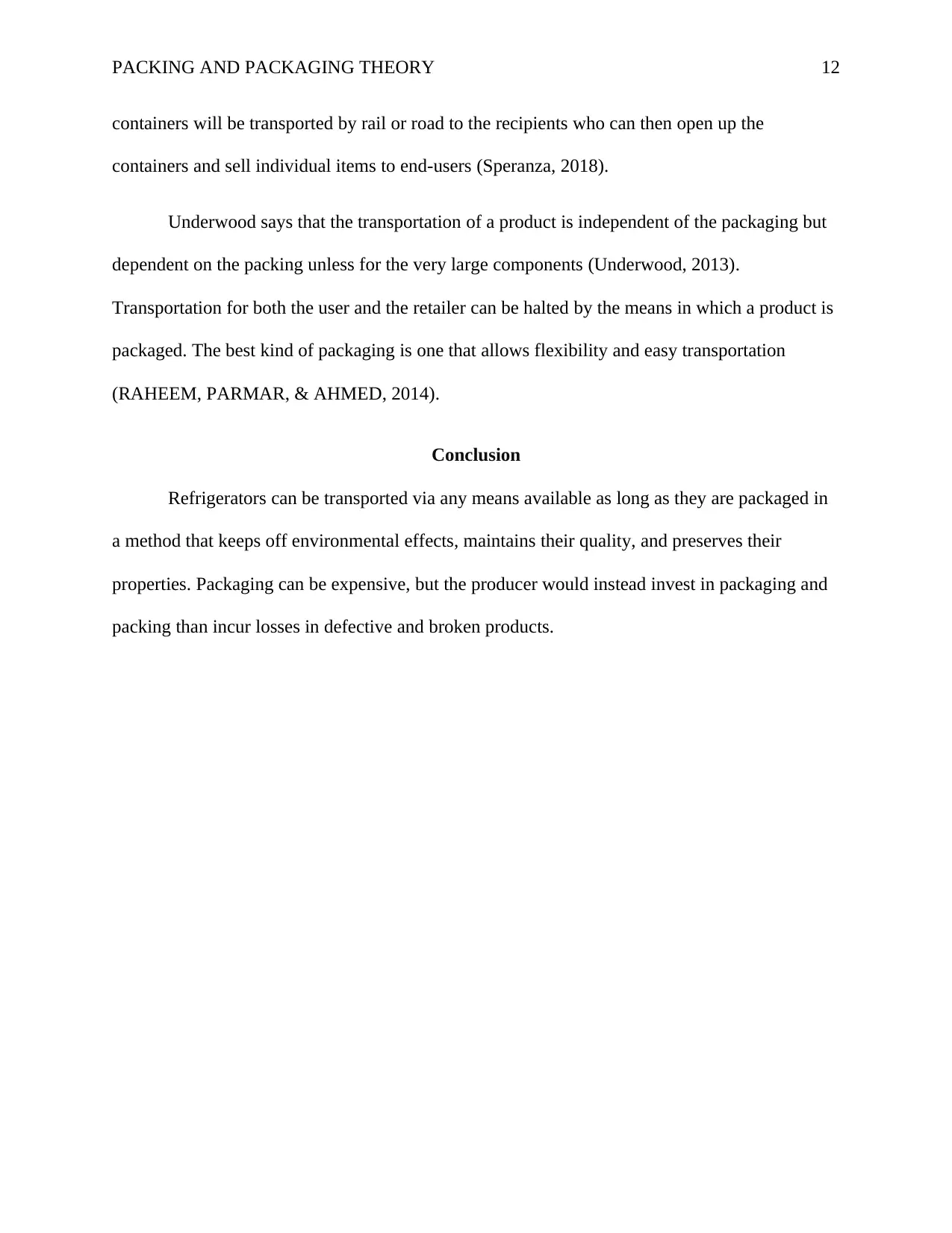
PACKING AND PACKAGING THEORY 12
containers will be transported by rail or road to the recipients who can then open up the
containers and sell individual items to end-users (Speranza, 2018).
Underwood says that the transportation of a product is independent of the packaging but
dependent on the packing unless for the very large components (Underwood, 2013).
Transportation for both the user and the retailer can be halted by the means in which a product is
packaged. The best kind of packaging is one that allows flexibility and easy transportation
(RAHEEM, PARMAR, & AHMED, 2014).
Conclusion
Refrigerators can be transported via any means available as long as they are packaged in
a method that keeps off environmental effects, maintains their quality, and preserves their
properties. Packaging can be expensive, but the producer would instead invest in packaging and
packing than incur losses in defective and broken products.
containers will be transported by rail or road to the recipients who can then open up the
containers and sell individual items to end-users (Speranza, 2018).
Underwood says that the transportation of a product is independent of the packaging but
dependent on the packing unless for the very large components (Underwood, 2013).
Transportation for both the user and the retailer can be halted by the means in which a product is
packaged. The best kind of packaging is one that allows flexibility and easy transportation
(RAHEEM, PARMAR, & AHMED, 2014).
Conclusion
Refrigerators can be transported via any means available as long as they are packaged in
a method that keeps off environmental effects, maintains their quality, and preserves their
properties. Packaging can be expensive, but the producer would instead invest in packaging and
packing than incur losses in defective and broken products.
⊘ This is a preview!⊘
Do you want full access?
Subscribe today to unlock all pages.

Trusted by 1+ million students worldwide
1 out of 16
Your All-in-One AI-Powered Toolkit for Academic Success.
+13062052269
info@desklib.com
Available 24*7 on WhatsApp / Email
![[object Object]](/_next/static/media/star-bottom.7253800d.svg)
Unlock your academic potential
Copyright © 2020–2025 A2Z Services. All Rights Reserved. Developed and managed by ZUCOL.

